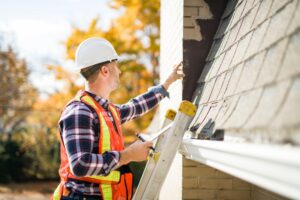
You probably don’t think about your roof often — and that’s fair. Most of us don’t, until something goes wrong.
But by the time you notice a leak, the damage has usually been building up for a while. And what might have been a small repair could now cost thousands.
The good news? You don’t need to be a roofing expert to catch problems early. With a few simple checks and an eye for detail, you can spot roof damage before it spirals out of control.
This guide will walk you through the warning signs to look out for — and when to take action.
Why Early Detection Matters
Roof repairs are rarely cheap. But the earlier you catch an issue, the easier (and more affordable) it is to fix.
Ignoring roof damage doesn’t just affect the outside of your home. Water leaks can lead to:
- Rotting timber in the loft
- Damaged insulation
- Mould and mildew on ceilings and walls
- Electrical hazards
Left too long, minor damage can turn into structural problems — and the cost can rise fast.
What Causes Roof Damage?
Roofs are built to last, but even the best ones face wear and tear over time. The most common culprits include:
Weather
Wind, rain, hail, and snow all put pressure on your roofing materials. Over time, this can loosen tiles, damage flashings, and lead to leaks.
Poor Installation
If a roof wasn’t installed correctly in the first place, it’s more likely to fail early. Gaps, uneven tiling, and low-grade materials are all red flags.
Age
Most roofs have a lifespan of 20–50 years depending on the material. As the roof ages, it becomes more vulnerable to cracking, shifting, and water damage.
Lack of Maintenance
Small issues often go unnoticed until they cause visible damage. Regular maintenance helps extend the life of your roof and catch problems early.
Warning Signs Inside the Home
You don’t need a ladder to spot roof damage. Some of the clearest signs appear inside your home.
Water Stains or Damp Patches
Discoloured spots on your ceiling or top-floor walls can signal a leak. Even small marks may indicate water is entering from above.
Mould or Mildew
Mould around ceiling edges or in the loft often points to excess moisture — which could be caused by a hidden roof leak or poor ventilation.
A Musty Smell in the Loft
A damp, stale odour in your attic can be a clue that water is getting in. Always check during daylight with the lights off — if you see sunlight coming through, it means the roof isn’t sealed.
Sagging Ceilings
A drooping ceiling may suggest water pooling above. If it looks misshapen or uneven, call a professional immediately.
Warning Signs Outside the Home
Walk around your home and look up. You’ll often be able to spot roof problems from the ground.
Missing or Slipped Tiles
Tiles that have moved out of place or fallen off are one of the most common (and obvious) signs of damage. Even a single missing tile can let water in.
Cracked, Broken, or Curled Materials
Tiles, slates, and shingles may crack or warp over time, especially after storms or prolonged exposure to sun and frost.
Moss and Algae Growth
A bit of moss on your roof isn’t unusual. But heavy build-up can trap moisture, loosen tiles, and lead to long-term damage.
Rusted Flashings
Flashings are the metal strips around chimneys, skylights, and valleys. If they’re rusted, bent, or missing, water can easily seep through the gaps.
Blocked or Overflowing Gutters
If water isn’t flowing through your guttering properly, it could be backing up under your roof or causing fascia damage. Keep an eye out for sagging or debris-filled gutters.
Specific Areas to Check
Chimney and Skylight Edges
These are common weak spots. Look for cracked sealant, water stains, or signs of separation where the roof meets the feature.
Roof Valleys
Where two roof slopes meet is where water naturally flows — and where damage often starts. Check for sagging, debris build-up, or signs of pooling.
Eaves and Soffits
Inspect the edges of the roof where it meets the walls. Water stains or wood rot here could signal a bigger issue above.
How Often Should You Inspect Your Roof?
Ideally, you should give your roof a quick visual check at least twice a year — once in spring and again in autumn.
It’s also a good idea to check after:
- Heavy storms or high winds
- Prolonged snow or ice
- A nearby construction project
- Trees have dropped large branches or debris
If your roof is over 20 years old, a professional inspection every year is worth considering.
When to Call in a Roofer
If you notice any of the issues mentioned above — or even if you’re just unsure — don’t wait.
Calling in a professional might save you thousands. A quick inspection can confirm whether you’re dealing with a minor patch job or something more serious.
A trusted roofer will give you honest feedback, options for repair, and advice on how to prevent further damage.
One such provider is Roofing Newcastle, who offer expert inspections, repairs, and maintenance across a wide range of roof types. They’ve seen every kind of roofing problem — and more importantly, they know how to fix them before they get worse.
Simple Ways to Prevent Roof Damage
You can’t stop the weather — but you can protect your roof with a few basic habits:
- Keep gutters clean to prevent water back-up
- Trim nearby trees to avoid branch damage
- Fix small issues quickly rather than letting them grow
- Avoid walking on your roof, which can loosen materials
- Book occasional professional inspections, especially if your home is older
These simple steps can extend the life of your roof and protect your home from the inside out.
Final Thoughts
Your roof is one of the most important parts of your home — and one of the easiest to forget.
But just a few minutes spent checking each year can make all the difference. Look inside and outside for warning signs. Don’t ignore water stains, missing tiles, or clogged gutters.
The sooner you catch a problem, the easier it is to fix — and the less you’ll pay down the line.
If you’re not sure what you’re looking at, or you’d rather leave it to a professional, getting a roof inspection from a trusted company is always a smart move. Peace of mind is worth it.
Read more:
How to Spot Roof Damage Before It Becomes a Costly Problem






